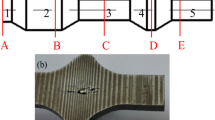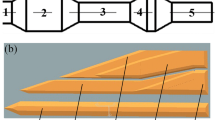Abstract
In this study, a rigid-plastic finite element method (FEM) simulation model for a multi-wedge cross wedge rolling (MCWR) was developed to analyze the generation mechanisms of internal defects. Two feature parts in MCWR, rod area and store area, were defined to analyze the internal defects mechanisms. The difference of stress states between the rod and store areas was pointed out and an insight into generation mechanism was concluded. Based on simulation, the influence of mold parameters was discussed and an optimized parameter group was achieved. The results indicate that the internal voids in the store and rod areas were extended from microcracks produced by shear stress cycle, and then develop to cracks due to the overlarge first principle tension stress caused by metal backflow. In a certain range, a smaller forming angle and a reasonable area reduction is good for avoid center voids in store area. Subsequently, the industrial test manifested the feasibility of study results.
Similar content being viewed by others
References
Wang MT, Li XT, Du FS, Zheng YZ (2005) A coupled thermal–mechanical and microstructural simulation of the cross wedge rolling process and experimental verification. Materials science and engineering a-structural materials properties microstructure and processing 391(1–2):305–312
Pater Z, Gontarz A, Weronski W (2006) Cross-wedge rolling by means of one flat wedge and two shaped rolls. Journal of materials processing technology 177(1–3):550–554
Dong YM, Lovell M, Tagavi K (1998) Analysis of interfacial slip in cross-wedge rolling: an experimentally verified finite-element model. Journal of materials processing technology 80–1:273–281
Li Q, Lovell M (2008) Cross wedge rolling failure mechanisms and industrial application. International journal of advanced manufacturing technology 37(3–4):265–278
Johnson W, Mamalis AG (1977) A survey of some physical defects arising in metal working processes. Proceedings of the 17th International MTDR Conference, London, UK, pp 607–621
Hu ZH, Xu XH, Sha DY (1985) Skew rolling and cross wedge rolling principles, processes and machines. Metall. Ind. Press, Beijing, China
Silva MLN, Pires GH, Button ST (2011) Damage evolution during cross wedge rolling of steel DIN 38MnSiVS5. Procedia Engineering 10:752–757
Smirnov VS (1947) The deformation process in cross rolling. Stal 7(6):351–358
Tselikov AI. Calculation (1962) theory of force on rolling machines. Moscow, Metallurgizdat, 10:930-3
Danno A, Awano TE (1976) Of rolling conditions on formation of central cavity in 2-roll cross rolling. Journal of JSTP 17(181):168–176
Dong YM, Tagavi KA, Lovell MR, Deng Z (2000) Analysis of stress in cross wedge rolling with application to failure. International journal of mechanical sciences 42(7):1233–1253
Fang G, Lei LP, Zeng P (2002) Three-dimensional rigid-plastic finite element simulation for the two-roll cross-wedge rolling process. Journal of materials processing technology 129(1–3):245–249
Zhao J, Shu XD, Hu ZH (2005) Study of stress distribution of forming slandering of automobile semi-axes with multi-wedge rolling by FEM simulation. ICMIT 2005: Control systems and robotics, Pts 1 and 2 6042: 4247–4247
Zhao J, Lu LQ, Hu ZH (2007) Study on varying rule of mechanical parameters in forming automobile semi-axes with multi-wedge cross wedge rolling. Proceedings of the international conference on mechanical engineering and mechanics 2007, vols 1 and 2: 1723–1727
Zhao J, Lu LQ (2009) The mechanism on defect of transition section with multi-wedge cross wedge rolling forming automotive semi-axis. Proceedings of the second international conference on modelling and simulation (icms2009) 6: 167–170
Hu ZH, Xu XH, Sha DY (1985) Skew rolling and cross wedge rolling—principles, processes and machines. Press, Beijing, China, Metall. Ind
Pater Z (2006) Finite element analysis of cross wedge rolling. Journal of materials processing technology 173(2):201–208
Silva MLN, Pires GH, Button ST (2011) Damage evolution during cross wedge rolling of steel DIN 38MnSiVS5. Procedia Engineering 10:752–757
Author information
Authors and Affiliations
Corresponding author
Rights and permissions
About this article
Cite this article
Zhou, J., Yu, Y. & Zeng, Q. Analysis and experimental studies of internal voids in multi-wedge cross wedge rolling stepped shaft. Int J Adv Manuf Technol 72, 1559–1566 (2014). https://doi.org/10.1007/s00170-014-5768-9
Received:
Accepted:
Published:
Issue Date:
DOI: https://doi.org/10.1007/s00170-014-5768-9




